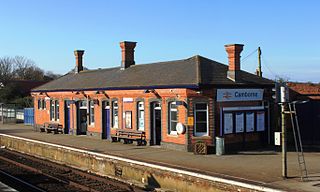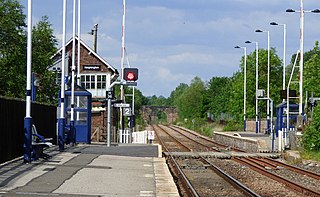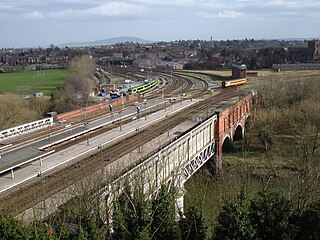
The Bodmin and Wenford Railway is a 6 miles 12 chains (9.9 km) heritage railway at Bodmin in Cornwall, England. Its headquarters are at Bodmin General railway station and it connects with the national rail network at Bodmin Parkway.

Plymouth railway station serves the city of Plymouth, Devon, England. It is on the northern edge of the city centre, close to the North Cross roundabout. It is the second busiest station in the county of Devon and the largest of the six surviving stations in Plymouth.

Devonport railway station serves the Devonport area of Plymouth in Devon, England. It is 248 miles 28 chains (399.7 km) from London Paddington measured via Box and Plymouth Millbay. It is managed by Great Western Railway.

Bromley Cross railway station, on Chapeltown Road in Bromley Cross, a suburb to the north of Bolton, England, is served by the Northern 'Ribble Valley' line 2+3⁄4 miles (4.4 km) north of Bolton. The station is just south of the point where the double line merges into one.

Shrewsbury railway station is in Shrewsbury, Shropshire, England. Built in 1848, it was designated a grade II listed building in 1969.

Crediton railway station is a railway station serving the town of Crediton in Devon, England. It is 7 miles 76 chains (12.8 km) from Exeter Central at milepost 179.25 from London Waterloo.

Bodmin Parkway railway station is on the Cornish Main Line that serves the nearby town of Bodmin and other parts of mid-Cornwall, England. It is situated 3 miles (4.8 km) south-east of the town of Bodmin in the civil parish of St Winnow, 274 miles 3 chains from London Paddington measured via Box and Plymouth Millbay. Network Rail’s National Rail Timetable dated May 2023 records the distance from London Paddington to Bodmin Parkway as 252.50 miles.

Par railway station serves the villages of Par, Tywardreath and St Blazey, Cornwall, England. The station is 281 miles 66 chains from the zero point at London Paddington measured via Box and Plymouth Millbay. It is the junction for the Atlantic Coast Line to Newquay.

St Austell station is a Grade II listed station which serves the town of St Austell, Cornwall, England. It is 286 miles 26 chains from the zero point at London Paddington measured via Box and Plymouth Millbay. The station is operated by Great Western Railway.

Camborne railway station serves the town of Camborne, Cornwall, England. The station is 313 miles 40 chains from the zero point at London Paddington measured via Box and Plymouth Millbay.

Heighington is a railway station on the Tees Valley Line, which runs between Bishop Auckland and Saltburn via Darlington. The station, situated 5 miles 62 chains (9.3 km) north-west of Darlington, serves the villages of Aycliffe and Heighington in County Durham, England. It is owned by Network Rail and managed by Northern Trains.

Plymouth Millbay railway station was the original railway terminus in Plymouth, Devon, England. It was used for passenger trains from 1849 to 1941. It was rebuilt in 1903.

Severn Bridge Junction is the area of railway lines just south east of Shrewsbury railway station, in Shropshire, England. It is controlled by a mechanical interlocked signal box of the same name, which is the largest operational mechanical signal box in the world. The Network Rail signalling area code is 'SBJ.'
There are seventeen disused railway stations on the Cornish Main Line between Plymouth in Devon and Penzance in Cornwall, England. The remains of nine of these can be seen from passing trains. While a number of these were closed following the so-called "Beeching Axe" in the 1960s, many of them had been closed much earlier, the traffic for which they had been built failing to materialise.

Devonport Kings Road railway station was the London and South Western Railway station in Devonport, Devon, England. It opened in 1876 and closed in 1964. For the first 14 years it was a terminal station with trains to London departing eastwards, but from 1890 it became a through station with trains to London departing westwards.

Plymouth Friary railway station was the London and South Western Railway (LSWR) terminus in Plymouth, Devon, England.

Totnes Signal Box is a Grade II listed former Great Western Railway signal box, located on Totnes railway station. It presently functions as a cafe.

Lostwithiel signal box is a Grade II listed former Great Western Railway signal box, located on Lostwithiel railway station in Cornwall, England. The signal box is situated at the northern end of Platform 1, adjacent to the level crossing.

The Liverpool Street signal box is a Grade II listed disused signal box at Liverpool Street tube station in London.

Birmingham New Street Signal Box is a railway signal box in Birmingham, central England, situated on the corner of Brunel and Navigation Streets and at the west end of the platforms of Birmingham New Street railway station. Opened on 3 July 1966, the brutalist structure is a grade II listed building for its architectural value and a prominent city centre landmark. It closed on 24 December 2022.



















